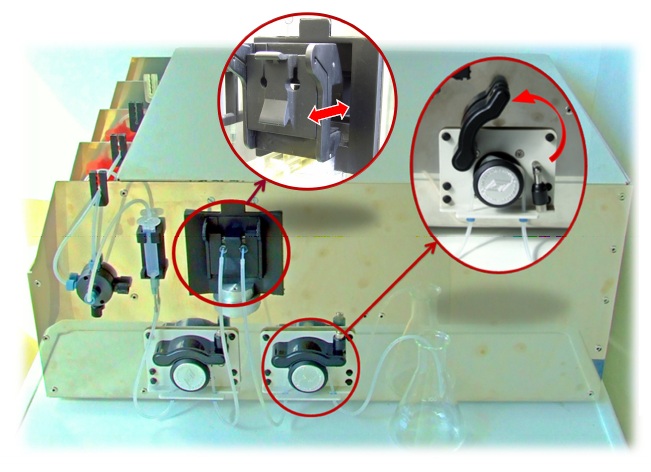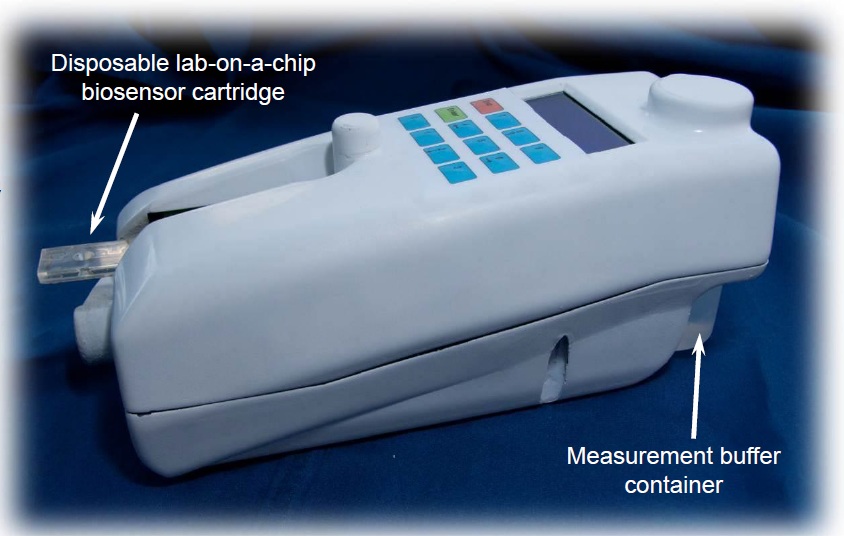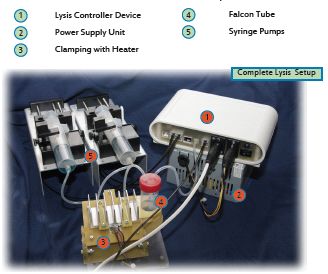 |
BMe Research Grant |

|
FACULTY OF ELECTRICAL ENGINEERING AND INFORMATICS
Department of Electronics Technology
Sensors and Microfluidics Laboratory
Research and development of multi-biosensor based devices and other microfluidic applications
Introducing the research area
Biosensors and microfluidics are emerging research fields in the scientific world. DNA based biosensors have recently gained much interest from the scientific community due to such possible fields of application like gene analysis, human diagnostics or environment monitoring. Current trends in biosensor research and development indicate many directions: to widen the spectrum of detectable molecules by means of new receptor structures, besides, to improve sensor parameters (detection limit, sensitivity, selectivity) using the established and proved principles, and to integrate these principles into point-of-care or laboratory devices. [Harsanyi, G.: Sensors in Biomedical Applications, Lancaster: Technomic Publishing Co, 2000. p. 350 p.].
Brief introduction of the research place
The laboratory of Sensors and Microfluidics has been engaged in the research of chemical and physical sensors since the end of the 90’s. Dr. Hunor Sántha has become the head of laboratory in 2004, after the former head of lab, Professor Harsányi was elected head of department. Being both a medical doctor and an electrical engineer, Dr. Santha has established the applied research and development of biomedical and biosensors, that has become the primary research direction of the lab by now. There are three active research areas in the lab: 1) development of comfortably wearable wireless biomedical sensors (ECG, pulse oximetry), 2) development of optical and electrochemical multi-biosensor platforms for label-free protocols, 3) research and development of microfluidic sample handling systems. The laboratory has been successfully involved in several national and international projects in the recent years, thus, the budget spent on research and development over the last 4 years exceeds 460 million forints.
History and context of the research
Nowadays, biosensors are becoming increasingly important both for the scientific world and the industry. The global biosensor market has reached US$11 billion in 2009, and the number of publications in the field exceeded many thousands in 2010. The field of application for biosensors, which by definition, contain biologically active material is fairly broad. Personal blood glucose meters are the most widespread commercial application of enzyme-based biocatalytic sensors, which uses the glucose oxidase enzyme to break blood glucose down, in order to measure the concentration of glucose. Most blood glucose meters on the market need only a small droplet of blood from the finger, thus providing a fast and painless method of blood glucose measurement for people suffering from diabetes mellitus or hypoglycemia. Potentially, the “analysis from one drop of blood” could be extended to other blood constituents, as well. Several researches around the world aim to develop a portable handheld device that could render the time consuming and costly laboratory tests unnecessary. Beside the research of receptor layers sensitive to new target molecules and their integration into analytical devices, the basic research and development of the established methods are also very important fields. Regarding biosensors, the main objective is to improve sensitivity, selectivity, reliability and reproducibility. Well educated, motivated and talented professionals from various fields of science (mechanical/electrical engineering, chemistry, biochemistry, biology) are involved to respond to this challenge.
The research goal, open questions
A biosensor is an analytical device that
generally consists of an active biological element (receptor) and a
physical-chemical transduction component (transducer). The receptor component is
responsible for capturing a target ligand while the transducer converts the
ligand-binding event into an electrical or optical signal that provides
information about the concentration of the analyte. Accordingly, possible
directions of biosensor research can be divided into two major categories. Receptor research
and development aims both at developing new receptor layers sensitive to
new target molecules, and improving the existing
receptor layers (e.g. the orientation of the immobilized molecules or the
nanostructure of the bioreceptor layer can highly affect some important
parameters of a biosensor, such as sensitivity, selectivity, etc.). Transducer
development is more focused on enhancing signal transducing/transmitting methods
to improve critical parameters, like sensitivity, detection limit,
reproducibility, readout time, etc. These two major fields are also part of the basic research activity of our laboratory.
A different orientation in our laboratory is device-level development which is dominated by two trends. Some readout technologies (e.g. electrochemical) are suitable for integration in a Point-of-Care (PoC) device. In this case, the aims are to reduce the dimensions (through higher level of integration) and to make them easier to use (e.g. compatibility with e-Health systems, operation from home, etc.). The other trend is the development of laboratory devices (e.g. our SPRi platform), targeting at reliable and high-throughput measurements (e.g. for pharmaceutical research).
Strongly connected to device development is the development of sample handling systems. Sample volumes to be handled are
getting smaller thanks to
the higher level of integration and the decrease in the sample volume required for the measurements (e.g. a single droplet of blood allows detailed analysis). However, the increasing number of blood
parameters to be measured and the advanced analytical protocols require more
sample handling steps, and consequently, more complex devices. Thus, microfluidic
sample handling devices must undergo significant development.
Since the application of disposable test stripes of human blood glucose meters, sample handling has passed two steps of
evolution on the market of the single-use point-of care
biological sample analyzing systems.
1.e.g. considering lateral-flow based ovulation or pregnancy tests, target
molecules are passed to the reaction zones (a result indicator line and a
diffusion-controll line) by diffusion, in a passive way, 2. e.g. the CoaguCheck
XS from Roche Diagnostics utilizes a 2 cm long channel where samples are driven
(by the capillary force) from the blood sample inlet to the 6 pieces of gold
electrodes by the controlled hydrophilicity of the channel walls. Two further steps will be needed to realize point-of-care applications
using more complex sample handling, and reaction/measurement protocols: 3.
active sample handling via integrated micropumps, 4. reliable, but disposable
integrated valves that can be mass-produced.
Although no PoC system can be found on the market with a complexity beyond steps 1 and 2, development of those devices is highly discussed in the fields of Lab-on-a-Chip (LoC), micro Total Analytical Systems (uTas), multi-biosensors and microfluidics
Methodology
Electrochemical techniques
(like Electrochemical Impedance Spectroscopy) have recently gained much
popularity. Since the working principles are simple, it enables fast measurement
and the electronics required for the measurement can be integrated into small
portable devices, which resulted in the rapid spread of the
electrochemical blood glucose meters, a worldwide success story of biosensors, at the expense of the older, optical-based
technique. For the electrochemical investigations we used two state-of-the-art,
pc-controlled laboratory potentiostats (Voltalab PGZ 301, Voltalab PST
50).
In contrast, surface plasmon resonance imaging
(SPRi), an optical measurement technique researched and used in our lab, has
the advantage of enabling several (100-1000) parallel measurements on the same
biosensor chip. Pharmaceutical industry could benefit from such a device because of the large number of control measurements required when testing active
substances. Besides, SPRi could also provide information on binding
kinetics which is a highly important field of research for the optimization of bioreceptor layers.
The instrument pool of our laboratory ensures carrying out of electrical, chemical and electrochemical measurements as well. Additionally to the numerous electrical testing and chemical laboratory instruments, professional contactless and touch thermometer devices and thermal chambers and a glovebox are available. We can validate experimental thermodynamical models and solve complex thermo measurement problems by means of these devices, as well as performing experiments in controlled environments (temperature, humidity, pressure and gaseous media). A separate section is allocated in the laboratory for the development of electronic circuits essential for the evaluation of signals supplied by our sensors.
Results
Over the 10 years of research and development, the laboratory has developed many unique prototypes that earned recognition.
The wireless pulse oximeter sensorhead, our most product orientated project, is capable of measuring the oxygen level of patients. Additionally to the sensor development, the project includes the design and development of analog and digital circuits, the microcontroller programming and high level programming for the PC, which evaluates and displays the measurement data. The project aims to produce the world’s smallest wireless pulse oximeter sensorhead.

This device provided a good opportunity for the head of laboratory – Dr. Hunor Santha – together with a senior fellow – Dr. Norbert Stubán – to set up a spinoff company named Arvus ltd. in 2007. The mission of the company is to collect and exploit those intellectual properties incubated at the department which the university cannot invest in, however, through the involvement of additional financial resources (venture capital firms, proposals, private investors, etc.) can be taken to the market.
Another wearable wireless medical sensor application of the laboratory is called HERMOS – Human ECG Recording and Monitoring System. This development resulted in a fully operational Home Monitoring System capable of monitoring various heart diseases. The system uses a wearable ECG to monitor the heart activity of the patient. The whole measurement process is fully automatic, the only task of the patient is to put the ECG electrodes on and turn the ECG device on. The remote Java application displays the measurement data in a web browser window. The application is stored on a low-power microcontroller based Web Server unit, thus the physician needs only a thin client (netbook or PDA) to display the results. A complete test including 40 healthy volunteers has been completed, where the system recorded and displayed their ECG curves successfully.
Surface Plasmon Resonance imaging (SPRi) is an emerging transducer method in the bio and life-science markets. It offers a new generation in the label-free analysis of bio-molecules, providing information on kinetic processes (association and dissociation), binding affinity and even concentration or real-time target molecule detection.


As a member of the Rapid-SPR project, the professionals of the lab has developed a small, fixed-angle SPR imaging device that enables the biochips to be prepared in an array format with up to 100 active sites (spots) on the gold coated glass biochip providing SPR information simultaneously. The main advantage of the system over the commercial devices is the easily reconfigurable flow cell system that provides different flow cells for different applications. Moreover, even the design and fabrication steps of a brand new cell structure can be done within a day thanks to the laboratory’s rapid prototyping machine.
As a platform technology, the SPRi device could be suitable for the research of any arbitrary protein (immuno sensor) or DNA-based biosensor. The modular and flexible reconfiguration of the flow cell enables the system to be adapted to different tasks and requirements.
Electrochemical Impedance Spectroscopy (EIS) is a widespread measurement method in the field of biosensor research and development due to its high sensitivity and simplicity (compared to the optical techniques). Within the confines of the project called DVT-IMP a small, handheld device has been developed which is capable of measuring EIS in standalone mode. Measurement control, curve fitting and data extraction are all implemented in the microcontroller so (unlike commercially available potentiostats) human data preprocessing or communication with a control PC is not required for data evaluation.

An enzyme based cell lysis device has been successfully developed during the project DINAMICS. Lysis refers to the disruption of a cell or virus, namely breaking the cellular membrane or protein capsule, so that the spilt out DNA and RNA contents, after further processing, can be detected. The device we developed can operate both in standalone mode and as a larger system component, and can also be easily integrated into automated systems. Validation with different human pathogens (Gram-positive, Gram-negative bacteria, viruses) has already been completed delivering the performance of established systems.

The purpose of microfluidic system developments is creating devices with integrated sample extraction, sample processing and data evaluation capabilities. The concept is called " lab-on-a-chip", i.e. they feature micro laboratories integrated into a single small microfluidic device. Jointly with GenoID ltd., the laboratory have developed a cheap, mobile microfluidic cartridge based device for the extraction and quality controlled stabilization of samples (under the aegis of Jedlik Ányos Program funded by the Hungarian Ministry of Economics and Transport). The manually operated cartridge eliminates previously unsolved problems as follows:
1. Provides parallel stabilization for the sample components (DNA, RNA, protein)
2. Controls the steps of sample processing
3. Ensures suitability of biological samples to be processed by the so called profiling technologies (i.e. biological measurements at high parallel processing rate). Stabilized sample components can be processed with a broad spectrum of medical applications (real-time PCR, cDNS expressive profiling, mass spectroscopic protein profiling, etc.)
4. Provides
contamination-free sample collection and even self-collection.

The capabilities of first prototypes have been tested in a particular medical application (HPV detection from cervical sample)
Besides, there are some other minor research and development
tasks going on in the laboratory in cooperation with renowned European research
institutes and universities.
Expected impact and further research
The platform technologies developed during the recent years offer a firm base for further system development.
In the market of the single-use point-of care
biological sample analyzing systems, sample handling has passed two steps of
evolution since the implementation of disposable test stripes of human blood glucose meters.
However, two more steps have to be made in order to realize point-of-care
applications using more complex sample handling, reaction and measurement
protocols: 3. active sample handling via integrated micropumps, 4. reliable, but
disposable integrated valves. The EIS platform developed in the lab has already
reached the evolution of the third step and within the confines of a currently running project
(financed by the GOP frame program) an integrated system is under development
that comprises the specifics of step four.
Our SPRi measurement platform can be suitable for the research of arbitrary protein (immuno sensor) or DNA-based affinity biosensor. The modular and flexible reconfiguration of flow cell enables the system to be adapted to various tasks and requirements. More than 20x20=400 miniature, independent reaction sites can be localized on an area of 15 x 15 mm2, and different biomolecules (proteins, nucleotides, etc.) as receptors can be immobilized onto each reaction sites. Introducing the sample through microfluidic channels or via automated micro pipetting, the analytes and their affinity and speed of reaction can be monitored.
Publications, references, links
5 highlighted publications from the last 5 years
1. Attila Bonyár, Hunor Sántha
Comparison of electrode setups for a custom built electrochemical measurement platform for DNA based biosensors.
In: 1st Bio-sensing Technology Conference.
Bristol, United Kingdom, 10-12 November, 2009, Paper
P2.3.12.
3D Rapid Prototyping Technology (RPT) as a powerful tool in microfluidic development.
PROCEDIA ENGINEERING 5: pp. 291–294. (2010)
Full document, DOI: 10.1016/j.proeng.2010.09.105
3. Attila Bonyár, Gábor Harsányi
AFM nanoshaving: a novel prospect for the structural comparison of bioreceptor layers.
In: Proc of the 34th International Spring
Seminar on Electronics Technology. Tatranska Lomnica, Slovakia,
12-15 November, 2011, IEEE, Paper G02.
4. Patent: Sántha H., Harsányi G., Stubán N.
Microfluidic channel, method for its implementation, and microfluidic system containing said channel.
File No: WO2009047573
Published in: 2009
Submitted in: Hungary
5.Khadro B, Santha H, Nagy P, Harsanyi G, Jaffrezic-Renault N
Comparison of the Performances of Conductometric Microsensors for Different Technologies and Designs of Interdigitated Electrodes.
SENSOR LETTERS 6:(3) pp. 413–416. (2008)
IF: 1.160, WoS link, Full document, DOI: 10.1166/sl.2008.060
and 5 highlighted publications from the period before that
1. Sántha H
Viewpoint – Medical sensors used for monitoring and diagnosis.
SENSOR REVIEW 25:(4) pp. 237–238. (2005)
2. Sántha, H., Dobay,
R., Harsányi, G.
Amperometric uric acid biosensors fabricated of various types of uricase enzymes.
IEEE SENSORS JOURNAL 3:(3) pp. 282–287. (2003)
WoS link, DOI: 10.1109/JSEN.2003.814655
3. Harsányi, G., Sántha, H.
Polytronics for Biotronics: Unique Possibilities of Polymers in Biosensors and BioMEMS?
In: 2nd International IEEE Conference on Polymers and
Adhesives in Microelectronics and Photonics. Zalaegerszeg, Hungary,
23-26 June, 2002, IEEE, pp. 211–215.
4. Harsányi G, Ballun G,
Bojta P, Gordon P, Sántha H
Multimedia for MEMs Technologies and Packaging Education.
MST NEWS 5: pp. 10–12. (2003)
5. Sántha, H., Harsányi,
G., Sinkovics, B., Makai, D.
A Microfluidic Electrochemical Cell Based on Microsystem Packaging Technologies Applicable for Biosensor Development.
In: 55th IEEE Electronic Components and Technology Conference. Lake Buena Vista, U.S.A, IEEE, pp. 588–592.
Sensors
and microfluidics laboratory
Participants:






